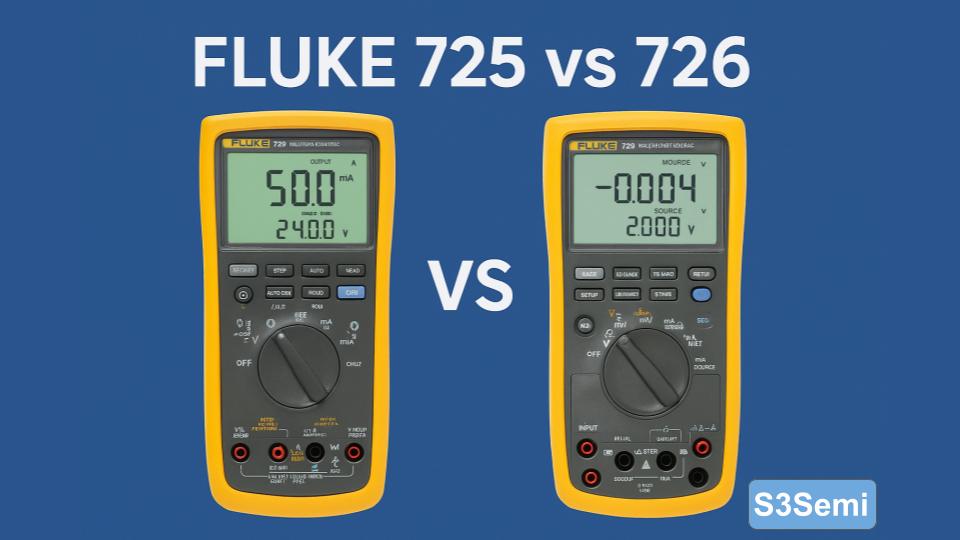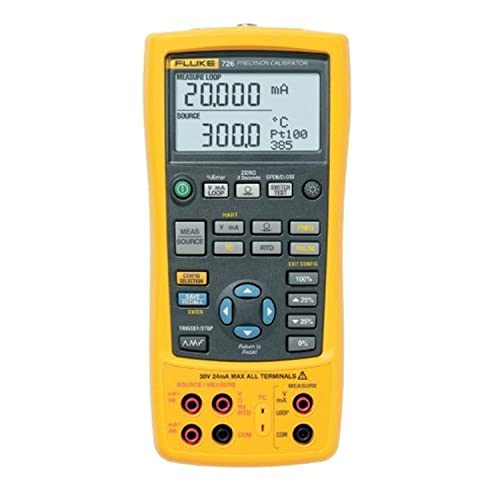🔧 Process technicians often need a reliable calibrator that can handle multiple signal types with precision.
Fluke’s 725 Multifunction Process Calibrator and the 726 Precision Multifunction Calibrator, are frequently compared.
🏷️ Fluke Calibrator Deals ⭐⭐⭐⭐
While they share many features, the 726 is designed with higher accuracy and advanced diagnostics, making it a step up from the 725.
📋 Overview of the Fluke 725
The Fluke 725 is a rugged, versatile multifunction process calibrator designed for field technicians who need to test and calibrate a wide variety of process instruments.
Key Features:
- Sources and measures volts, mA, resistance, frequency, and pressure (with modules).
- Simulates and measures RTDs and thermocouples for temperature calibration.
- Step and ramp functions for testing transmitters.
- Compact and durable design for industrial environments.
- Accuracy suitable for general-purpose calibration tasks.
Best For: Field technicians who need a reliable, all-around calibrator without requiring ultra-high precision.
⚡ Overview of the Fluke 726
The Fluke 726 Precision Multifunction Calibrator takes everything the 725 offers and adds higher accuracy, wider ranges, and advanced diagnostic functions.
Key Features:
- Higher accuracy than the 725 (±0.01% vs ±0.02% typical for certain signals).
- Expanded source and measure ranges.
- Ability to simultaneously measure and source signals — ideal for transmitter testing.
- Custom RTD and thermocouple tables for specialized calibration.
- More advanced troubleshooting and calibration diagnostics.
Best For: Process professionals who demand high-precision calibration and advanced diagnostics for critical instrumentation.
⚖️ Fluke 725 vs 726: Side-by-Side
| Feature | Fluke 725 | Fluke 726 |
|---|---|---|
| Type | Multifunction calibrator | Precision multifunction calibrator |
| Accuracy | High (general purpose) | Very high (precision level) |
| Source/Measure Capabilities | Volts, mA, ohms, frequency, TCs, RTDs, pressure | Same as 725, with higher accuracy and wider ranges |
| 💳 Pricing | 💲Check Price | 💲Check Price |
| Simultaneous Source/Measure | ❌ No | ✅ Yes |
| Custom Sensor Tables | ❌ No | ✅ Yes |
| Display | Standard LCD | Higher resolution LCD |
| Best For | General process calibration | Precision calibration & diagnostics |
✅ Pros and Cons
Fluke 725
✔ Versatile, covers most process signals
✔ Step and ramp functions for loop testing
✔ Rugged and reliable in the field
✘ Not as accurate as 726
✘ Cannot measure and source at the same time
Fluke 726
✔ Higher accuracy for critical applications
✔ Simultaneous source and measure capability
✔ Custom RTD/TC tables for special sensors
✔ Advanced diagnostic functions
✘ More expensive
✘ Slightly more complex to use
📝 Which One Should You Choose?
- Choose the Fluke 725 if you need a reliable, general-purpose calibrator that covers most industrial signals at a lower cost.
- Pick the Fluke 726 if you require precision, simultaneous measurement and sourcing, and custom sensor calibration, making it better suited for advanced process technicians and calibration labs.
In short, the 725 is the workhorse calibrator, while the 726 is the precision specialist for demanding environments.




